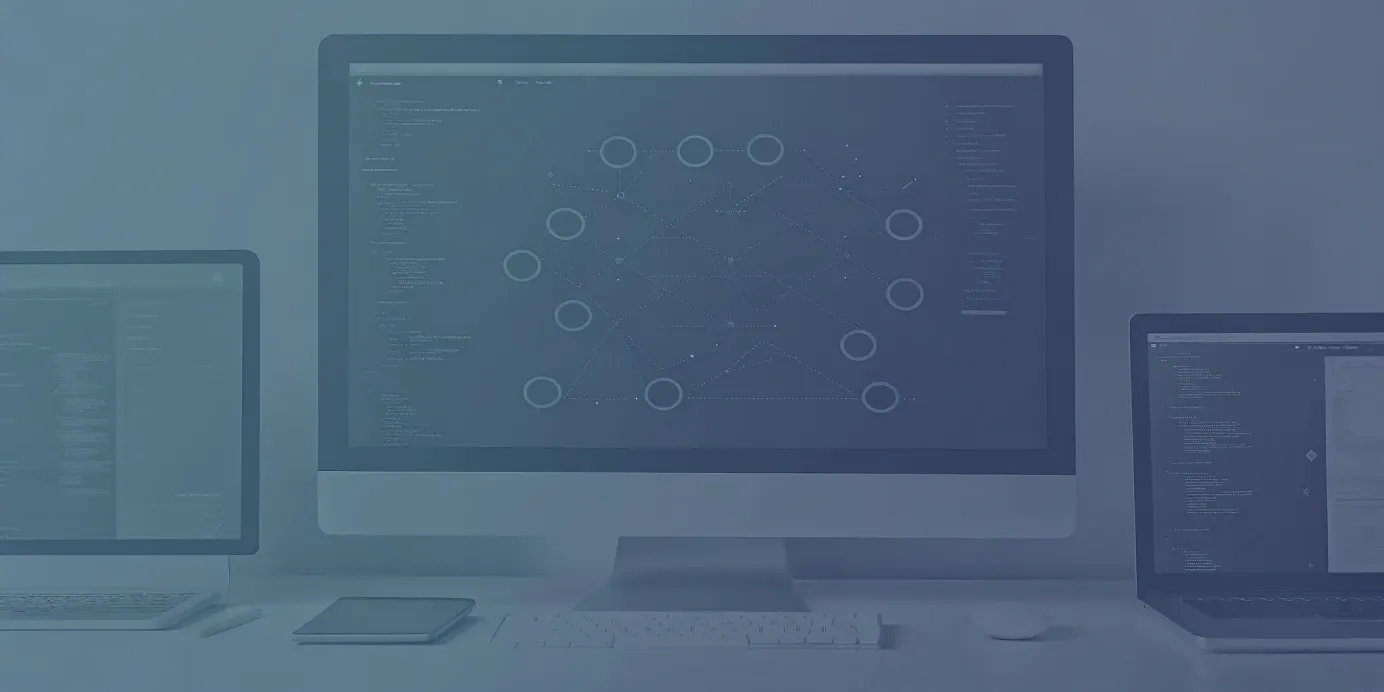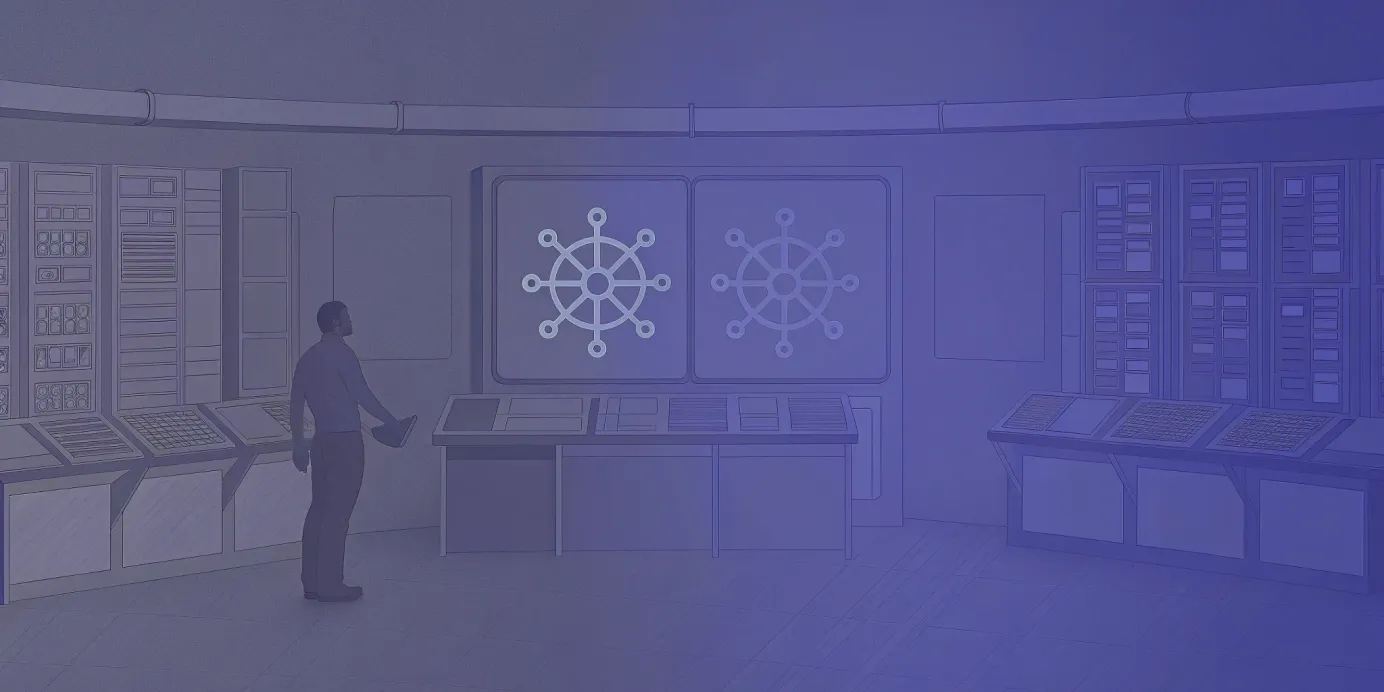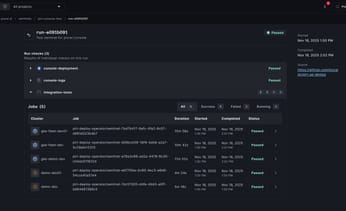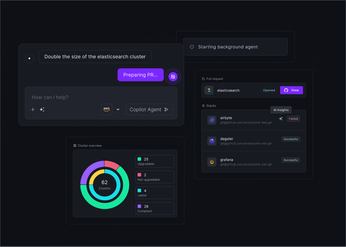
How to Automate CVE Checks in Kubernetes
Learn how to automate CVE checks in Kubernetes, streamline vulnerability detection, and improve security across your clusters with practical, actionable steps.
Turning on a vulnerability scanner for your Kubernetes clusters can feel like opening a firehose. You're suddenly flooded with hundreds, if not thousands, of alerts, many of which are low-priority or irrelevant to your production environment. This constant noise leads to alert fatigue, where critical threats get lost in the shuffle.
Effective security isn't just about finding every possible Common Vulnerabilities and Exposures (CVEs); it's about identifying and prioritizing the ones that pose a real risk. To do this at scale, you must automate CVE checks in Kubernetes with a system that provides context, filters out noise, and turns raw data into actionable intelligence. Here, we'll explore how to build that system.
Unified Cloud Orchestration for Kubernetes
Manage Kubernetes at scale through a single, enterprise-ready platform.
Key takeaways:
- Automate scanning within your CI/CD pipeline: Integrate vulnerability checks directly into your build and deployment processes to identify and fix security issues before they ever reach production. This makes security an automated, preventative step in your workflow, not a manual afterthought.
- Use policy enforcement to block threats proactively: Implement a policy engine like OPA Gatekeeper to create automated rules that prevent insecure workloads from being deployed. This allows you to enforce security standards, such as blocking images with critical CVEs, across all your clusters.
- Centralize security management for fleet-wide consistency: Adopt a single platform to view vulnerability data, manage security tools, and apply updates across all your clusters. This unified approach eliminates configuration drift and provides a complete picture of your security posture from one dashboard.
What Are CVEs in Kubernetes?
CVEs are standardized identifiers for publicly disclosed security flaws affecting software components—many of which appear throughout the Kubernetes stack. In a cluster, CVEs can surface anywhere: container base images, application dependencies, Kubernetes binaries, Helm charts, or third-party operators. These vulnerabilities typically arise from unpatched software, insecure defaults, or weak configurations. Each CVE entry includes a unique ID, description, and severity rating, giving security and DevOps teams a shared language for tracking and prioritizing risks. Understanding where CVEs originate is the foundation for building contextual and automated Kubernetes security workflows.
Why Vulnerability Management Matters
Kubernetes provides flexibility but not inherent security. Without deliberate hardening, the platform can expose your workloads to privilege escalation, data exfiltration, or lateral movement attacks. The number of disclosed Kubernetes-related vulnerabilities continues to rise, reflecting the ecosystem’s rapid growth and complexity. Proactive vulnerability management—scanning, classifying, and remediating known issues—serves as a critical early warning system. It helps you detect and address exploitable weaknesses before attackers do, maintaining the confidentiality, integrity, and availability of workloads across environments.
Common Kubernetes Vulnerabilities
Most Kubernetes vulnerabilities trace back to misconfigurations or unpatched components. Overly permissive RBAC roles, public dashboards, and exposed etcd instances are frequent culprits. Insecure images are another major source—teams often deploy containers built on outdated or vulnerable base layers. Poor network segmentation, missing PodSecurityPolicy (or its successor, Pod Security Standards), and weak secrets management also leave clusters open to compromise. These issues are preventable with proper governance, automated scanning, and least-privilege configurations.
The Problem with Manual CVE Checks
Manual vulnerability checks don’t scale in a Kubernetes ecosystem that’s constantly changing. Each deployment may pull in dozens of container images and dependencies, all of which need to be tracked against new CVE disclosures. For platform engineers, maintaining visibility across hundreds of clusters and workloads quickly becomes unmanageable. Manual audits lead to inconsistent coverage and missed threats. Automation (integrated into CI/CD pipelines, admission controls, and runtime scanners) is essential for continuously detecting, correlating, and prioritizing vulnerabilities across your Kubernetes fleet.
Tools for Automating CVE Detection
Automating CVE detection in Kubernetes requires a layered, end-to-end security strategy. No single scanner provides full coverage, so teams must combine multiple tools—each targeting a different layer of the stack. Effective vulnerability management integrates static analysis of manifests, container image scanning, and runtime monitoring to catch risks early and continuously. This approach embeds security into the CI/CD lifecycle, ensuring vulnerabilities are discovered before deployment and monitored throughout runtime. With the right integrations, security becomes an automated, collaborative process across development and operations teams.
Open-Source Scanners
Open-source scanners provide an accessible starting point for catching misconfigurations and policy violations in Kubernetes manifests. These tools analyze YAML definitions and cluster configurations against best practices to identify potential security gaps before deployment.
- kube-score performs static analysis of object manifests and assigns risk scores with actionable recommendations.
- kubeaudit audits clusters for insecure configurations, such as privileged containers or missing security contexts.
- kubesec analyzes Pod and Deployment specs to detect risky settings and suggest hardening steps.
Lightweight and CI/CD-friendly, these tools are ideal for early-stage checks during development or pre-deployment validation.
Container Image Scanners
Most CVEs originate from vulnerable base images or outdated dependencies. Container image scanners identify and track these issues across build, registry, and runtime stages.
- Integrate scanning into your build pipeline to catch issues early.
- Continuously monitor registries for new CVE disclosures affecting existing images.
- Perform pre-deployment scans to enforce image hygiene.
- Enable runtime scanning to detect newly published vulnerabilities impacting running workloads.
Tools like Trivy, Grype, and Clair can be automated at each lifecycle stage to maintain ongoing visibility and compliance.
Kubernetes-Native Security Tools
Kubernetes-native security platforms extend beyond scanning, offering contextual insights and policy enforcement. These tools integrate directly with Kubernetes APIs to connect CVE data with workloads, namespaces, and ownership metadata.
- Calico and Kyverno can enforce admission controls that block deployments with critical vulnerabilities or insecure configurations.
- Platforms like Falco add runtime detection, monitoring for anomalous behavior and potential exploit activity.
By correlating vulnerability data with cluster context, these tools help teams prioritize remediation based on real-world exposure and workload importance.
Key Integration Points
The effectiveness of CVE automation depends on tight CI/CD integration. Embed scanning and policy enforcement directly into build and deployment workflows:
- Static analysis of manifests before commit or during pull request reviews.
- Image scanning post-build to prevent pushing vulnerable artifacts to the registry.
- DAST or runtime validation in staging environments before production release.
By automating these checks, your pipelines become security-aware—failing builds with critical issues, surfacing actionable reports, and ensuring only compliant workloads reach production.
How to Automate CVE Checks
Automating CVE checks transforms security from a reactive cleanup effort into a proactive, continuous process. Instead of chasing vulnerabilities after they reach production, you can design a system that detects, prioritizes, and remediates them automatically throughout the deployment lifecycle. This structured approach—spanning continuous scanning, policy enforcement, intelligent alerting, and automated remediation—creates a scalable, auditable framework for managing risks across your entire Kubernetes ecosystem.
Set Up Continuous Scanning
The backbone of an automated CVE strategy is continuous scanning. Rather than performing one-off audits, implement scanners that continuously monitor your container registries, cluster configurations, and running workloads. These tools should automatically rescan whenever new CVEs are published or when workloads change. Continuous scanning ensures visibility into both new deployments and long-running services, giving platform teams real-time insight into evolving threats and maintaining an accurate security posture at all times.
Configure Scan Policies
With scanning in place, define clear policies that align with your organization’s risk tolerance. Policies determine which vulnerabilities should block a build, trigger alerts, or be ignored. For example, fail builds when “Critical” or “High” severity CVEs are detected, or restrict scans to specific registries and namespaces. Enforce these policies through admission controllers such as OPA Gatekeeper or Kyverno, preventing workloads that violate your standards from being deployed. Well-tuned policies turn scanners into proactive security gates rather than passive reporting tools.
Manage Scan Results
Vulnerability scanners can produce overwhelming amounts of data. To make the output actionable, aggregate results centrally, filter out noise, and prioritize based on severity, exploitability, and workload context. Integrate scanners with issue-tracking systems like Jira to automatically create and assign remediation tasks, ensuring every vulnerability has ownership and traceability. Platforms like Plural provide unified dashboards that consolidate CVE data across all clusters, helping teams focus on critical issues and demonstrate compliance with minimal manual effort.
Integrate Scans into Your CI/CD Pipeline
Embedding CVE scanning directly into your CI/CD pipeline is the most effective way to stop vulnerabilities before they reach production. Add automated scan stages to your build workflows in Jenkins, GitLab CI, or GitHub Actions. Each image should be scanned immediately after build, with pipelines configured to fail if disallowed vulnerabilities are found. This “shift-left” approach shortens the feedback loop, allowing developers to fix issues during development rather than during production firefights, while maintaining security as part of normal delivery processes.
Build Remediation Workflows
Detection is only half the battle—remediation closes the loop. Automate fix workflows that patch or replace vulnerable components without manual intervention. For example, configure automated pull requests to update base images in Dockerfiles or bump dependency versions in Helm charts. A GitOps-driven system like Plural can propagate these changes across clusters, ensuring consistent patching and reducing mean time to remediate (MTTR). By linking detection directly to automated remediation, teams can maintain secure, up-to-date Kubernetes environments at scale with minimal operational overhead.
Best Practices for Managing CVEs at Scale
Detecting CVEs is only the starting point—scaling vulnerability management across multiple Kubernetes clusters demands structured automation, consistent policies, and operational efficiency. As environments grow, ad hoc scanning quickly becomes ineffective. The key is to embed security throughout your delivery pipelines, centralize management, and automate remediation workflows without slowing down developer velocity. The following best practices help maintain a unified, resilient security posture across your entire Kubernetes ecosystem.
Optimize Scan Frequency
Vulnerability management must be continuous and multi-layered. Integrate scanning at every stage of your application lifecycle:
- Pre-deployment: Scan container images and manifests before merging or pushing to registries.
- Pipeline: Embed scanning into CI/CD workflows to automatically block builds with critical CVEs.
- Runtime: Continuously monitor workloads for newly published vulnerabilities affecting live deployments.
This layered model ensures consistent visibility and coverage, minimizing the chance of unpatched CVEs reaching production.
Define and Enforce Policies
Detection without enforcement leaves gaps. Use a Kubernetes-native policy engine such as OPA Gatekeeper or Kyverno to codify and enforce security requirements. Policies can block workloads that use images with critical vulnerabilities, mandate secure contexts, or disallow unverified base images. Enforced policies act as automated guardrails—reducing manual oversight, ensuring compliance, and maintaining a documented audit trail for security reviews and regulatory reporting.
Develop an Alerting Strategy
Unfiltered vulnerability data leads to alert fatigue. Design alerting workflows that prioritize signal over noise.
- Prioritize by context: Rank CVEs by severity, exploitability, and whether the vulnerable package is active in production.
- Automate routing: Integrate scanners with communication and tracking systems such as Slack, PagerDuty, or Jira to automatically create actionable tickets.
- Focus on trends: Use dashboards to monitor patterns rather than reacting to every alert.
Context-aware alerting ensures engineers focus on real threats instead of drowning in notifications.
Optimize for Performance
Security should enhance, not hinder, delivery speed. To minimize friction:
- Cache scan results for unchanged image layers to eliminate redundant work.
- Schedule deep scans during off-peak hours to reduce compute contention.
- Use lightweight runtime agents optimized for low overhead.
These optimizations make vulnerability detection and enforcement nearly invisible to developers, preserving productivity while maintaining strong defenses.
Manage Security Across Multiple Clusters
Managing CVE detection and policy enforcement manually across clusters is inefficient and error-prone. Centralized orchestration ensures uniform protection at scale. A management layer such as Plural’s Global Services lets you define security configurations once—policies, scanners, and monitoring agents—and replicate them across every cluster automatically. This unified control plane delivers consistent visibility, policy enforcement, and vulnerability tracking across environments, allowing teams to maintain compliance and protection without repetitive setup or configuration drift.
Common Challenges and How to Solve Them
Automating CVE checks across Kubernetes environments brings major security gains, but it also introduces operational and architectural challenges. Scanners can consume cluster resources, alerting systems can overwhelm teams, and compliance reporting can become complex at scale. Overcoming these issues requires balancing automation with control—using policy-driven workflows, efficient resource management, and strong integrations. The following sections outline common pain points and proven solutions to keep your automated vulnerability management program reliable and efficient.
Handling Resource Constraints
CVE scanners are inherently resource-heavy, often competing with workloads for CPU and memory. Left unmanaged, they can degrade cluster performance or even trigger autoscaling events. To mitigate this:
- Schedule scans during off-peak hours to reduce contention with production workloads.
- Apply Kubernetes resource quotas and limits to constrain scanner pods.
- Use taints and tolerations to isolate security workloads to dedicated nodes.
- Leverage automation platforms like Plural to apply consistent resource policies across clusters.
This approach ensures vulnerability detection remains continuous without compromising application performance or reliability.
Preventing Alert Fatigue
Unfiltered alerts are one of the biggest barriers to effective vulnerability management. Teams quickly lose focus when flooded with notifications of varying severity. Combat alert fatigue by:
- Tuning scan policies to target only critical or exploitable CVEs.
- Contextualizing alerts—prioritize vulnerabilities in internet-facing services or active workloads.
- Centralizing alert data in a unified dashboard for fleet-wide visibility.
Plural’s single-pane-of-glass console aggregates scanner output, helping engineers filter, correlate, and respond to the most impactful threats first.
Simplifying Complex Integrations
Security automation often spans multiple scanners, policy engines, and monitoring tools, which can introduce misconfigurations and maintenance overhead. The key is standardization through Infrastructure as Code (IaC).
- Define security components declaratively using IaC frameworks to ensure reproducibility.
- Use Kubernetes-native orchestration to manage deployment and configuration at scale.
- Adopt Plural Stacks, which streamline IaC-based deployment and configuration of your entire security stack.
This standardization minimizes manual setup, reduces drift, and ensures consistent behavior across clusters and environments.
Meeting Compliance Requirements
Auditors expect proof of continuous scanning, remediation tracking, and consistent enforcement of security policies. Manual reporting can’t meet these demands. To stay compliant:
- Automate reporting from scan and ticketing data.
- Maintain traceability between vulnerability discovery and remediation actions.
- Leverage centralized audit logs for all security-related changes.
Plural’s audit logging and reporting features simplify compliance workflows, providing verifiable evidence that CVEs are detected, tracked, and resolved in line with standards like FedRAMP or HIPAA.
Integrating with Version Control
Shifting security left requires embedding vulnerability detection into your version control and CI/CD systems. This ensures insecure code and images never reach production.
- Trigger scans on every pull request and block merges with critical CVEs.
- Automate security gates within pipelines for tools like GitHub Actions, GitLab CI, or Jenkins.
- Adopt a GitOps model—each change is versioned, reviewed, and automatically scanned before deployment.
Plural’s Continuous Deployment engine, built on GitOps principles, integrates seamlessly with your repositories, enabling version-controlled, automated security checks across your entire Kubernetes fleet
Automate Kubernetes Security with Plural
Manually checking for CVEs across a handful of Kubernetes clusters is tedious; across an entire fleet, it’s impossible. As environments scale, security teams are often flooded with alerts from disparate tools, while platform teams struggle to prioritize and patch vulnerabilities in a timely manner. This reactive approach creates security gaps and slows down development. Effective Kubernetes security requires automation that is deeply integrated into the deployment lifecycle, from initial code commit to production monitoring.
Plural provides a unified platform to automate security and compliance across your entire Kubernetes fleet. Instead of stitching together multiple point solutions for scanning, policy enforcement, and monitoring, Plural integrates these capabilities into a single, GitOps-driven workflow. This approach allows you to move from a reactive security posture to a proactive one, where vulnerabilities are detected early, remediation is automated, and security policies are consistently enforced. With Plural, you can manage the security of hundreds of clusters from a single pane of glass, reducing operational overhead and ensuring your infrastructure remains secure and compliant without compromising on speed or scalability.
Plural's Built-in CVE Detection
Plural embeds security directly into your workflow with automated CVE scanning. By integrating directly with Trivy, a comprehensive open-source vulnerability scanner, Plural provides continuous detection across all your managed clusters. This isn't a bolt-on feature; it's a core part of the platform that scans your container images and other artifacts for known vulnerabilities without requiring any complex setup. The results are surfaced directly in the Plural UI, giving your team immediate visibility into potential risks. This built-in capability eliminates the need to manage and integrate a separate scanning tool, simplifying your security stack and ensuring that vulnerability detection is a consistent, automated part of your operations from day one.
Automate Remediation Workflows
Identifying a vulnerability is only half the battle. Plural helps you close the loop by connecting detection directly to remediation through its GitOps-based continuous deployment engine. When a scan identifies a CVE in a running service, the fix is as simple as updating an image tag in a Git repository. Plural’s agent detects the change and automatically orchestrates the rollout of the patched version across all targeted clusters. This creates a clear, auditable, and automated workflow for remediation. Instead of manually tracking vulnerabilities and coordinating updates, your team can rely on a streamlined process that treats security patches just like any other code change, significantly reducing the mean time to remediation (MTTR).
Monitor Your Fleet from a Single Pane of Glass
Managing security across a distributed fleet of Kubernetes clusters creates significant visibility challenges. Plural solves this by consolidating all security and operational data into a single, intuitive dashboard. From this central console, you can view CVE scan results, monitor deployment statuses, and inspect the health of every cluster in your fleet. This unified view eliminates the need to switch between different tools and contexts, allowing your team to quickly assess your organization's overall security posture. You can easily identify which clusters are most at risk, prioritize patching efforts based on severity, and drill down into specific workloads for detailed analysis, all from one place.
Enforce Security Policies Across All Clusters
A strong security posture relies on proactive prevention, not just reactive fixes. Plural enables you to define and enforce security policies consistently across your entire fleet. Using our Global Services feature, you can deploy and manage policy engines like OPA Gatekeeper as a standardized component on every cluster. This allows you to implement powerful admission controls that, for example, could block the deployment of any container image with critical vulnerabilities or enforce specific pod security standards. By codifying your security requirements and automating their enforcement, you can ensure that all workloads comply with your organization's policies before they ever run in production.
Streamline Patching and Updates
Vulnerabilities can exist anywhere in your stack, from your application code to the underlying Kubernetes components and add-ons. Plural’s Continuous Deployment engine streamlines the entire patching and update process. It automates the lifecycle management of essential services like ingress controllers, service meshes, and observability agents. When a new patch is available for a component, you can roll it out across your fleet through a controlled, GitOps-driven workflow. This ensures that your entire infrastructure stack remains up-to-date and secure, reducing the risk of exploitation and minimizing the manual effort required to maintain a healthy and secure Kubernetes environment at scale.
Related Articles
Unified Cloud Orchestration for Kubernetes
Manage Kubernetes at scale through a single, enterprise-ready platform.
Frequently Asked Questions
My team already uses an open-source scanner. What's the advantage of using a platform like Plural? Open-source scanners are great for identifying vulnerabilities, but detection is only the first step. The real challenge is managing and remediating those findings at scale. Plural integrates CVE detection directly into a complete deployment and management workflow. Instead of just giving you a list of problems, it provides a single console to view vulnerabilities across your entire fleet and connects that information to a GitOps-driven process that automates the rollout of patches. This closes the loop from detection to remediation, which standalone scanners can't do.
How does Plural help with the actual remediation of CVEs, not just detection? Plural treats security patches like any other code change by leveraging a GitOps workflow. When a vulnerability is found in a container image, the fix is to update the image tag in your Git repository. Plural’s Continuous Deployment engine detects this commit and automatically orchestrates the deployment of the patched service across all relevant clusters. This creates a repeatable, auditable trail for every fix and removes the manual effort of coordinating updates, significantly reducing the time it takes to resolve a vulnerability.
Will continuous scanning slow down my clusters or CI/CD pipelines? We designed our security features to minimize performance impact. For CI/CD pipelines, scanning is optimized by caching results for unchanged image layers, which avoids redundant work and keeps builds fast. For runtime scanning within clusters, Plural uses efficient tools like Trivy and relies on a lightweight agent architecture. You can also use standard Kubernetes practices, like scheduling and resource quotas, to control when scans run and how many resources they consume, ensuring security checks don't become a bottleneck.
What about vulnerabilities that we can't fix right away or are false positives? Real-world vulnerability management requires flexibility. Within your scan policies, you can configure rules to handle these exceptions. For example, you can create policies to ignore specific CVEs with a documented justification, set severity thresholds to only block critical issues, or establish grace periods for new vulnerabilities to give your team time to develop a patch. This allows you to manage risk pragmatically without halting development for issues that have been accepted or are not immediately actionable.
How does Plural ensure consistent security policies across hundreds of different clusters? Maintaining consistency across a large fleet is a core challenge that Plural is built to solve. Using our Global Services feature, you can define a security configuration, such as a set of OPA Gatekeeper policies or standardized RBAC rules, just once. Plural then automatically replicates and enforces that configuration across every cluster you target. This eliminates configuration drift and ensures that all your clusters adhere to the same security and compliance standards without requiring manual intervention on each one.
Newsletter
Join the newsletter to receive the latest updates in your inbox.









